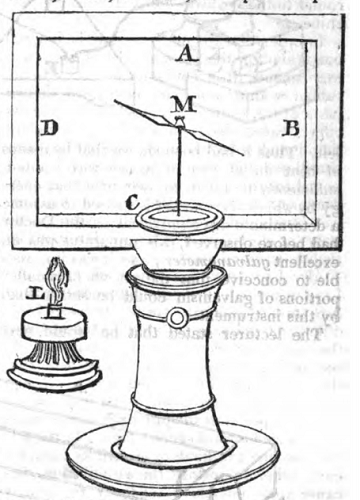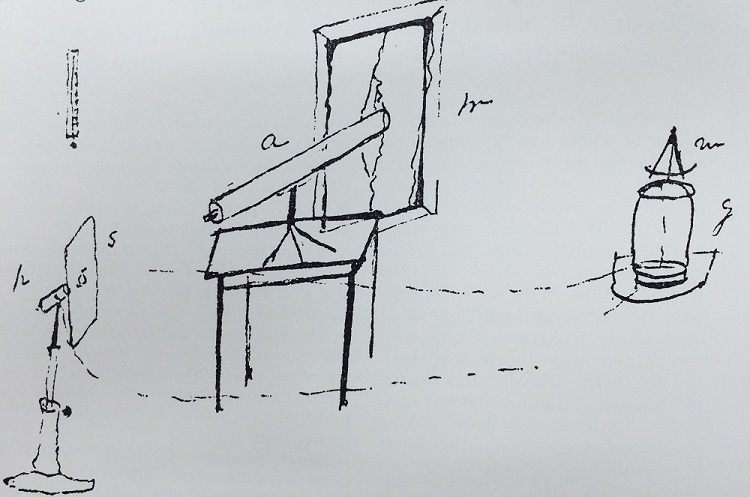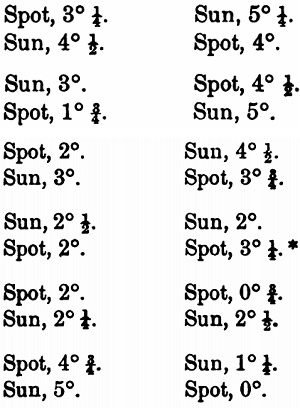Introduction
One of the most remembered experiment done by Joseph Henry was the detection of sunspots being cooler on sun by using thermo-electrical device. With conversion of heat energy from radiation of sun to electrical current, the amount of heat generated from sunspots was determined by measuring the current with galvanometer.
Thermoelectrical apparatus was used by Joseph Henry for testing reflection of heat from moon (with modelling moon as ice) and for creating sparks as well. (see P.185 of “The Papers of Joseph Henry, volume 7” and P.32 of “The Papers of Joseph Henry, volume 4”) It is a still widely used instrument nowadays for accurately measuring temperature (with Seebeck Effect) and temperature control (with Peltier Effect).
The Seebeck effect

The idea of electricity generation from heat was first found by Thomas Johann Seebeck in 1823 (See The London Mechanic’s Register, P.406). By putting bismuth and antimony in an alternating manner to form a rectangle (See picture above) and heating one junction, Seebeck was able to deflect a compass placed in the middle of the rectangle, which means a current flowing through the loop.
See Seebeck effect under this session for more details.
Spark generated from thermoelectricity
From student notebook of Samuel Sherrerd 1837 (See Classnotes) on the lecture of thermoelectricity, it is mentioned that generating spark from thermoelectricity was first proposed by Henry, first observed in Italy and first observed by Henry in England. Joseph Henry demostrated the generation of sparks with thermopile, made of bismuth and antimony plates, and a coil in his lecture on Natural Philosophy.
From The Papers of Joseph Henry, Vol. 3, on April 22 1837, Joseph Henry did the experiment of spark generation from thermoelectric apparatus and “ribbon coils” with Prof Wheatstone and Prof Daniell, with success. (See P.304 to P.306 of The Papers of Joseph Henry Vol. 3)
Joseph Henry Experiment on Sunspots
On 4th January, 1845, Professor Joseph Henry, together with Mr Stephen Alexander (his brother-in-law), carried out the first sunspot experiment to investigate the temperature difference between the sunspots and bright parts of sun. The experimental set-up was clearly drawn in The Papers of Joseph Henry Vol. 6 [i], in which the procedure was mentioned as well. But the experimental procedure was described more clearly in the report Joseph Henry given to American Philosophical Society[ii]. The next paragraph summarized the procedure depicted.
The diagram below was the hand-drawn set-up by Joseph Henry.

_____________________
[i] P.146 of “The Papers of Joseph Henry, volume 6”
[ii]“Observations of relative radiation of the solar spots”, Proceedings of the American Philosophical Society, vol. iv, P. 173-176. Or see P.226 of “Scientific Writings of Joseph Henry, Part I”
The experiment was carried in a darkened room. A Fraunhoffer telescope (a), which suffered to project out of the window (w), was used to project the images of sunspots or bright parts of sun on a screen(s). The screen had a hole of size of the end of pile and only the umbra part of sunspot was thrown on there. The end of thermopile was fastened to the screen using soft beas wax, which is believed to be used as an insulation to heat from parts of sun not studying. The thermopile (p) together with a galvanometer (m) showing arbitrary temperature reading in scale of Melloni, is called thermo-multiplier which was actually created by French Astronomer M. Melloni. Joseph Henry modified the multiplier by placing two bar magnest, arranged in the form of the legs of a pair of dividers in a vertical plane above the needle (see the seemingly “m” letter in the above diagram), which can be used to adjust the sensitivity and zero-points of the device. The result of the first experiment, done on 4th Jan 1845, is shown below.

The thermo-multiplier was in fact the most delicate measure of heat known at that time[iii]. For more details of the thermoelectrical device, please refer to thermo-multiplier under the same session.
_____________________
[iii] Para. 88 of “The Chemical Forces, Heat-Light-Electricity / An Introduction to Chemical Physics”, textbook for colleges used in 1870s